
The best firearm in the world will perform horribly if not fed equally good ammunition. A well-designed round can significantly increase the accuracy and stopping power of any caliber bullet.
Ballistics is the science of how ammunition operates. Ballistics is a science which is important for soldiers, law enforcement, hunters, and anyone who seeks to protect their life, their home, and their family.
The study of ballistics can help any shooter to achieve better results from their rifle, pistol, or shotgun.
Ballistics Information
How do bullets fly?
This document attempts to explain the basics of the complicated subject of bullet motion through the atmosphere and avoids formulas as well as mathematics, but expects familiarity with the way of physical thinking. It includes new experimental observations of bullets fired from small arms, both at short and at long ranges. Numerous illustrations are included and can be viewed via links to promote further understanding. This article is also thought as an introduction for all types of readers (hunters, sportsmen, ballisticians, forensic scientists), interested in the “mysteries” of the exterior ballistics of bullets, fired from small arms.
Internal Ballistics
This page presents a summary of internal ballistics theory and offers some programs and peak pressure measuring device.
Calibers
The Handgun Ammunition Information Resource
Timing a Ballistics Experiment
Many experiments require several processes to coincide with an event of unknown timing. Photographing a projectile in flight, for example, requires accurate coordination of the camera, sensors and flash lamps to capture a projectile of unknown speed. In this study, we examine various ways to control experiments of this nature using the LabSmith LC880 Programmable Experiment Controller.
Interchangeability Chart
Useful chart showing amunition interchangeablity. This chart answers the question Which ammunition can you use in which firearms?
Ballistics Chart
Ballistics Chart for Military Ammunition
Basic Ballistics
As shooters, we are all interested in where the bullet goes once we have fired the gun. The ability to place the bullet where we want it is vital to any accurate shooter, and an understanding of ballistics is necessary to accomplish that in a consistent and reliable fashion. The body of knowledge as to the factors effecting the flight of the bullet from the instant it leaves the muzzle of the gun until it strikes the target is termed External Ballistics, and that’s the subject of this discussion.
Bullets
Descriptions of various types of amunition.
9mm
Information on the ubiquitous 9mm cartridge.
6.8 SPC
Information on Remington’s 6.8×43 SPC caliber ammunition.
5.7×28
Information on FN’s 5.7×28 caliber ammunition.
Sectional Density
Brief description of Sectional Density.
Ballistics Software
Directory of ballistics software.
Ballistics Information from Ammunition Manufacturers
Remington
Remington Centerfire Pistol and Revolver Ammunition Ballistics
Alliant Powder
Reloaders’ Guide
IMR
IMR Handloader’s Guide for Smokeless Powders
Accurate Smokeless Powder
Ammunition Information from the United States Army
TM 43-0001-27
United States Army Technical Manual 43-0001-27: Army Ammunition Data Sheets; Small Caliber Ammunition
FM 4-30-13
United States Army Field Manual 4-30-13: Ammunition Handbook: Tactics, Techniques, and Procedures for Munitions Handlers
FM 6-40: Chapter 3 – Ballistics
From FM 6-40: Tactics, Techniques, and Procedures for Field Artillery Manual Cannon Gunnery
FM 6-16
Tables for Artillery Meteorolgy (Electronic) Ballistic Type 3 and Computer Messages
FM 6-16-2
Tables for Artillery Meteorology (Visual) Ballistic Type 3 and Computer Messages and Limited Surface Observations
Wound Ballistics
International Wound Ballistics Association
Devoted to the medical and technical study of wound ballistics, including evaluation of literature in the field as well as encouraging and promoting new work in wound ballistics
Wound Ballistics Research of the Past Twenty Years: A Giant Step Backwards
Wound ballistics research is supposed to aid the surgeon in providing optimal care for the wounded, but recent trends in ballistics research have not provided the surgeon with objectively determined information. Twenty years ago, wounds from penetrating projectiles were likely to be treated in a rational and effective manner; today many surgeons are prone to remove excessive amounts of tissue when treating wounds caused by what they assume to be “high-velocity” projectiles.
Management of Penetrating Neck Trauma
Management of neck trauma from low and high velicity penetrations.
Ammunition Forensics
Ballistic Imaging: Not Ready for Prime Time
Following the sniper attacks that plagued Washington, D.C., Maryland and Virginia in the early fall of 2002, gun control advocates intensified their demands that the federal government develop a “ballistic fingerprint” database. Legislators in several states and in Congress, including long-time gun control advocate Sen. Charles Schumer (D.-N.Y.), have proposed bills requiring gun manufacturers to test fire all new guns and to retain the cartridge case and bullet images. Some proposals would require manufacturers to supply the test information to a central agency, such as a state bureau or the federal Bureau of Alcohol, Tobacco, Firearms and Explosives (BATFE), while others would have manufacturers store and maintain the data themselves.
Ballistic Fingerprinting
The gun prohibitionists have been using the recent serious of murders in the Washington, DC area as an argument for what they call “ballistic fingerprinting.” What is this? Can it work?
Technical Evaluation: Feasibility of a Ballistics Imaging Database for All New Handgun Sales
Automated computer matching systems do not provide conclusive results. Rather, a list of potential candidates are presented that must be manually reviewed. When applying this technology to the concept of mass sampling of manufactured firearms, a huge inventory of potential candidates will be generated for manual review. This study indicates that this number of candidate cases will be so large as to be impractical and will likely create logistic complications so great that they cannot be effectively addressed.
Ballistics Matching Using 3D Images of Bullets and Cartridge Cases
Microscopic impressions (triations) found on the surface of fired bullets are routinely used as a means to associate a questioned bullet with a suspect weapon. Such association is possible because the striations found on the surface of fired bullets are imprinted on them by the microscopic imperfections found in the gun’s barrel.
Development of NIST Standard Bullets and Casings Status Report
In April 1998, two prototype standard bullets were developed at the National Institute of Standards and Technology (NIST). In October 1999, prototype standard casings were also developed at NIST. The standard bullets and casings are intended for use in Federal, State, local, and international crime laboratories as reference standards. The implementation of standard bullets and casings will help verify that the computerized optical-imaging equipment used in those laboratories is operating properly. These standard bullets and casings are being developed to enable nationwide and worldwide ballistics measurement traceability and unification. Test results at NIST indicate that the prototype standard bullets have essentially identical signature marks and minimal geometrical nonuniformity. Additional testing performed at the Bureau of Alcohol, Tobacco and Firearms (ATF) National Laboratory Center and at Forensic Technology Inc. (FTI, Canada) has also shown that these prototype bullets have unique properties, specifically repeatable and reproducible signature marks. The digitized bullet signature is stored in a computer and can be used for reproducing the same bullet signature anytime. This project report addresses the prototype design, manufacturing technique, testing results, potential enforcement impact and continued development of the standard bullet.
Association of Firearm and Tool Mark Examiners
In recognition of the need for the interchange of information, methods, development of standards, and the furtherance of research, a group of skilled and ethical firearm and/or toolmark examiners met together regularly prior to 1969. In that year they formed the Association of Firearm and Tool Mark Examiners recognizing that firearm and toolmark identification, though involving similar disciplines, require separate and distinct basic knowledge.
Books on Ballistics
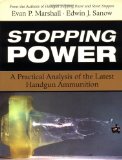
Stopping Power: A Practical Analysis of the Latest Handgun Ammunition
Evan Marshall and Ed Sanow rocked the firearms world with the release of Handgun Stopping Power and Street Stoppers. Both books predicted the effectiveness of all types of ammunition by studying the results of real-life shootings rather than relying on laboratory tests that ignored the dynamics of an actual gunfight. This third book in the series provides the very latest street results of all the major handgun calibers, from .22 LR to .45 ACP, as well as popular rifle and shotgun loads. It also contains chapters on short-barrel ballistics, the emergence of the hot new .357 SIG caliber, the continued success of the .40 S&W, the development of the latest exotic ammo, the effectiveness of black powder firearms and a brand-new ammo test protocol based on the results of the many gunfights of U.S. Border Patrol officers.
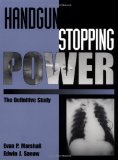
Handgun Stopping Power : The Definitive Study
Dramatic first-hand accounts of the results of handgun rounds fired into criminals by cops, storeowners, cabbies and others are the heart and soul of this long-awaited book. This is the definitive methodology for predicting the stopping power of handgun loads, the first to take into account what really happens when a bullet meets a man.
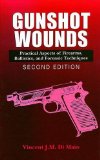
Gunshot Wounds: Practical Aspects of Firearms, Ballistics, and Forensic Techniques, Second Edition
Written by the nation’s foremost authority on gunshot wounds and forensic techniques as they relate to firearm injuries, Gunshot Wounds: Practical Aspects of Firearms, Ballistics, and Forensic Techniques, Second Edition provides critical information on gunshot wounds and the weapons and ammunition used to inflict them. The book describes practical aspects of ballistics, wound ballistics, and the classification of various wounds caused by handguns, bang guns, rifles, and shotguns. The final chapters explain autopsy technique and procedure and laboratory analysis relating to weapons and gunshot evidence.
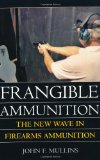
Frangible Ammunition: The New Wave in Firearms Ammunition
Frangible Ammunition represents the first viable revolutionary change to firearms science in the past 100 years! A polymer-compound round that produces no splashback and vastly decreased ricochets, frangible ammo is ideal for marksmanship training for both indoor and outdoor ranges, tactical team training, close-in engagement of metal targets and specialized service use. As such, it is the safest full-power training ammo for police and military shooters, civilian range owners and casual shooters. Despite its widespread acceptance, however, there has been no in-depth study of this cutting-edge round . . . until now. This book remedies that by teaching the potential user what a frangible round is, what they can and cannot be used for, how to construct safe training devices and facilities and the proper street and service uses for the round.
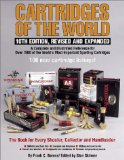
Cartridges of the World (Cartridges of the World)
This benchmark volume is the foremost source for cartridge information. Hunters, target shooters, military history buffs, ammunition reloaders and cartridge collectors alike will find all the answers to their cartridge and shotshell questions in this comprehensive book that includes 1,500+ cartridges.
This reference book includes detailed photos, dimensional drawings and loading data. Descriptions of obsolete American cartridges tell the tale of ammunition used by settlers, cowboys and outlaws during the nation’s westward expansion, and offer insights into unusual rounds that never caught on. Hunters and shooters can improve their success with the useful ballistics tables.
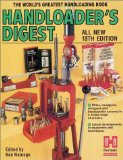
Handloader’s Digest: The World’s Greatest Handloading Book (Handloader’s Digest, 18th ed)
Handloaders are meticulous hobbyists who constantly search for better loads, components, and the tools to assemble cartridges. They expect the best from their components and tools, and this updated digest is an assemblage of authoritative articles discussing various facets of the reloading hobby. New indepth articles from expert writers cover casting bullets, working handloads, choosing the right components for the job, new techniques, ballistics, reloading safety, and much more. Enthusiasts will gain insight into new reloading trends, as well as available equipment and accessories from major manufacturers. Extensive and valuable reference information includes listings of all handloading periodicals and books, plus directories of products and manufacturers.
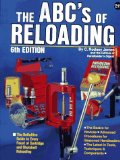
ABC’s of Reloading (ABC’s of Reloading)
Starting with the basics, this guide leads the reader through the process of reloading with ease. Perfect for beginners and a great refresher for experienced reloaders, the book first discusses all the necessary tools and accessories needed to get started, then goes through step-by-step instructions and safety tips for loading your own metallic cartridges and shotshells. Helpful illustrations guide readers through each step and make the process easy to understand. The ABC’s of Reloading covers all aspects of the hobby, from benchrest loading techniques, to ballistic software, to competition and hunting loads and more. It also includes a comprehensive directory of reloading manufacturers. The guide carefully pieces together steps and techniques for reloading into an understandable process, outlining the basic procedures and providing information on cartridge cases, primers, powders, bullets, equipment and much more, putting beginners on the road to becoming experts!
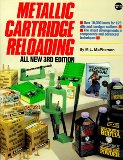
Metallic Cartridge Reloading
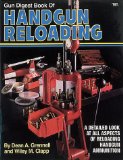
Gun Digest Book of Handgun Reloading
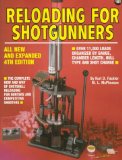
Reloading for Shotgunners (Reloading for Shotgunners)
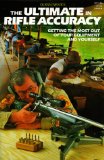
The Ultimate in Rifle Accuracy: A Handbook for Those Who Seek the Ultimate in Rifle Accuracy; Whether It Be for Competition, Testing, or Hunting
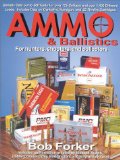
Ammo and Ballistics
All you ever needed to know about ammunition has finally been collected in one volume!
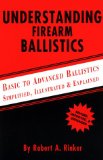
Understanding Firearm Ballistics
The original text of Understanding Ballistics has been edited, improved, & expanded with up-to-date information. Throughout are more formulas, detailed explainations & examples, more draawings, charts, and technical details explaining basic to advanced firearm ballistics, in a simplified and easy to follow style. This is the newest edition of the bible of the shooting sports. A must for all police officers, hunters, target shooters, handloaders, whether begineer or expert. This book is a “gotta have.”
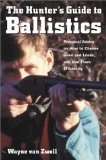
The Hunter’s Guide to Ballistics: Practical Advice on How to Choose Guns and Loads, and Use them Effectively
Now for the first time, here is a book written specifically for hunters about the guns and loads that they use. In this complete and fully illustrated digest, you’ll read about such diverse topics as: how to improve your long-range shooting; how to shoot accurately in winds of any speed or direction; how to solve the problems associated with shooting up and down hills; what causes mirage and how to read it; why some bullets shoot tighter groups farther away; how gunpowder is made; why bullets that move left also rise; which cartridges are suitable for everything plus comprehensive ballistics tables.
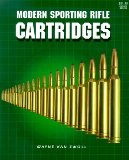
Modern Sporting Rifle Cartridges
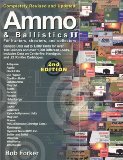
Ammo and Ballistics II
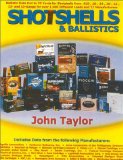
Shotshells and Ballistics
There is a bewildering array of commercially loaded shotgun shells for sale, from the .410 to the 10-gauge. In fact, there are more types of shells and shot sizes on the market now than ever before. With the overwhelming selection of shells available, here, finally, is a practical, reasonably priced book that makes sense of it all. It lists commercially available shotshell loads from the .410-bore to the 10-gauge, in all shot sizes available, different shot types (lead, steel, bismuth, tungsten, and others) so that the shooter or hunter can quickly find what will be best for the gun he has and the game or targets he wants to shoot. Each shotgun shell with each loading has its own table–over 1,600 tables!!–showing shot size; weight of shot; recoil; average number of pellets in the shell; manufacturer’s order number; shell length and type of hull; type of wad; and whether the shot is buffered or not. In addition, each table contains data that details velocity (in 10-yard intervals from 0 to 70 yards); average pellet energy; and time of flight in seconds. This book includes complete ballistic tables for every hull length and every shot-size load made from the following manufacturers: Aguila Ammunition, Armscor, ARMUSA, Baschieri & Pellagri, Bismuth Cartridge Company, Brenneke, Clever s.r.l., Dionisi, Eley Hawk, Estate Cartridge Company, Federal, Fiocchi, Gamebore, Hevi-Shot (now loaded exclusively by Remington), Kent, Lightfield, PMC, Polywad, Remington, RIO, RST, Sellier & Bellot, and Winchester. In addition, this informative reference contains authoritative articles on the history and development of shotshells and the components and technical data that govern the production of shotshells. Never before has so much information on shotshells and ballistics been placed in a single book. Accentuated with photos from the field and the range, this is a reference book unlike any other.
Do you have any reference material regarding the advantages vs disadvantages of using full metal jacket rounds as compared to hollow point rounds? It seems that safety considerations would determine that hollow point ammunitioon would be deemed safer as they would have a tendency to stay within the confines of an original target and not leave the target and injure a second unintentional target. Full metal jacket rounds are likely to leave the confines of the original target and injure a second target> Am I correct in this assumption? Any techniucal info would be appreciated.
Comments are closed.